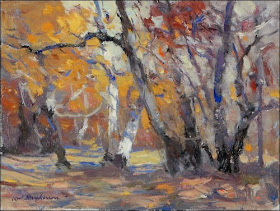I have been watching the PBS painting series called Passport and Palette. It is a great program and I highly recommend it. I noticed that Kevin Macpherson, who is one of the principle artists, uses the term "color note" rather extensively. Not knowing exactly what he meant I did a little research, and here is what I found.
In a book called Fill Your Oil Paintings with Light and Color, Kevin provides a brief description and justification for using "color note" rather than other terms. Here is what he says:
"What you need to do first is observe nature, to see everything as shapes of color. Proper values (lights and darks) are very important in a painting. However, I try to eliminate the term value, because we don't see in values of black and white. Nature displays itself in full spectrum. Color has three qualities: hue, value and chroma. I will use the term color or color note interchangeably to mean the sum of these qualities. Analyze everything as a particular color note." [emphasis added]
So a color note is mixed paint that has a particular hue, value, and chroma (or intensity). Look how Kevin is able to place color notes together to make an effective painting.
Perhaps Kevin got his inspiration from Charles Hawthorne who was an American portrait painter who founded the Cape Cod School of Art. Hawthorne's reputation as a great painter and educator attracted scores of artists, and his unconventional approach to teaching color theory became legendary.
For instance, Hawthorne would make students paint using only a putty knife. The clumsy tool forced students to apply large dollops of paint, making it impossible to accurately render a model's features. The object of painting these "mud-heads," as they were called, was to capture the effects of sunlight on the figure using only large, simple masses of color (see the example to the right). Perhaps these masses of color are what Hawthorne was thinking of when he said, "Beauty in art is the delicious notes of color one against the other."
I believe that if you can learn to think of color as color notes, it will makes the process of seeing and mixing accurate colors easier.
This concept also helps us to paint what we see (that is, shapes, colors, and edges) rather than what we know (such as, trees, faces, or cars). Hawthorne also taught that painting is not like drawing but is about "putting the right color note in the right place". When you do this the image you are trying to paint will emerge automatically.
Lastly, color notes have an attractive music analogy. Notes in music have edges just like color notes do. The beginning and end of each note in a song can be hard or soft similar to painted notes. Audible sounds have similar qualities of pitch and intensity. These elements of music combine to give each note a particular tone or "color". By placing musical notes together we create beautiful sounds. That is not much different than what we do when painting with color notes.
Here is a view of a handful of color notes from another of Kevin's paintings. See how each note has its own unique hue, value, and chroma. Combine those colors with variations in shape and edges and you see Kevin has made a beautiful medley for the eye.







Thanks for sharing great thoughts on color note.
ReplyDeleteWe are quite close to your category. You can check us here http://surepaint.com.au
sweet sweet color notes amirite boys
ReplyDelete